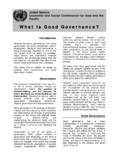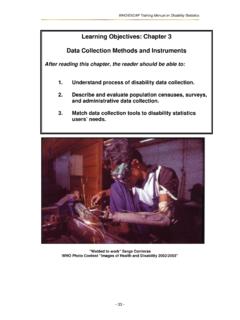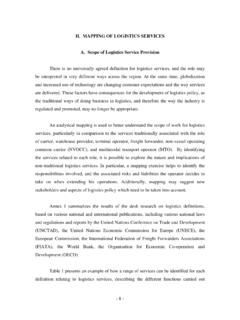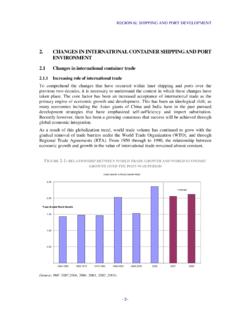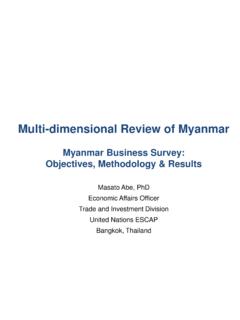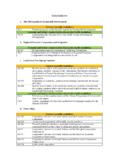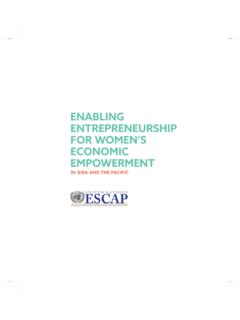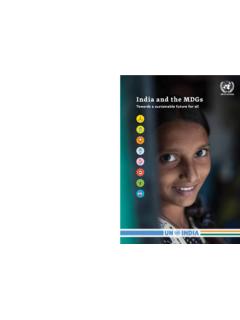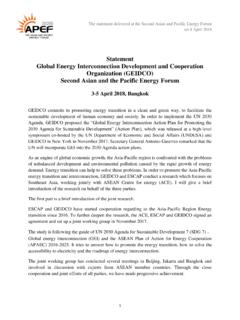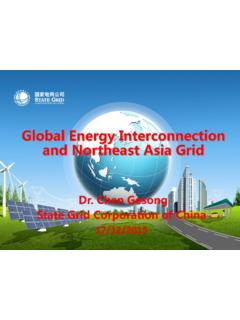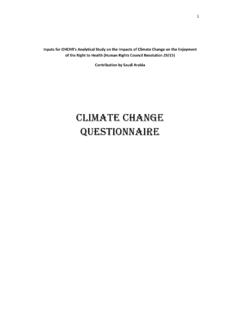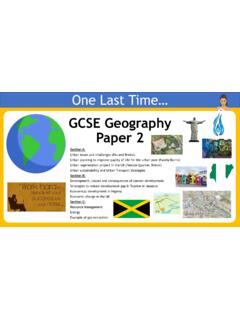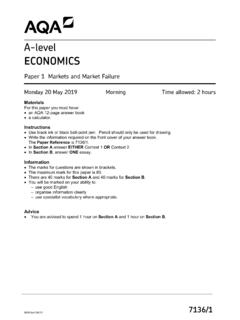Transcription of BATTLING CONGESTION IN MANILA: THE EDSA PROBLEM
1 Transport and Communications Bulletin for Asia and the Pacific No. 82, 2013 45 BATTLING CONGESTION IN MANILA: THE EDSA PROBLEM Yves Boquet ABSTRACT The urban density of Manila, the capital of the Philippines, is one the highest of the world and the rate of motorization far exceeds the street capacity to handle traffic. The setting of the city between Manila Bay to the West and Laguna de Bay to the South limits the opportunities to spread traffic from the south on many axes of circulation. Built in the 1940 s, the circumferential highway EDSA, named after historian Epifanio de los Santos, seems permanently clogged by traffic, even if the newer C-5 beltway tries to provide some relief. Among the causes of EDSA perennial difficulties, one of the major factors is the concentration of major shopping malls and business districts alongside its course.
2 A second major PROBLEM is the high number of bus terminals, particularly in the Cubao area, which provide interregional service from the capital area but add to the volume of traffic. While authorities have banned jeepneys and trisikel from using most of EDSA, this has meant that there is a concentration of these vehicles on side streets, blocking the smooth exit of cars. The current paper explores some of the policy options which may be considered to tackle CONGESTION on EDSA . INTRODUCTION Manila1 is one of the Asian megacities suffering from the many ills of excessive street traffic. In the last three decades, these cities have experienced an extraordinary increase in the number of vehicles plying their streets, while at the same time they have sprawled into adjacent areas forming vast megalopolises, with their skyline pushed upwards with the construction of many high-rises.
3 The joint processes of globalization, outsourcing, and the relocalization of manufacturing activities have been accompanied by a rise in the purchasing powers of many people in developing Asian countries, which has allowed them to acquire motorized vehicles, motorbikes and automobiles, even if profound inequalities exist in regard to the capacity to acquire a vehicle (Cervero 2013). It has resulted in a rapidly increasing CONGESTION of the streets, especially in cities where the urban fabric is traditionally made of narrow roads not suitable for heavy traffic. CONGESTION not only slows down considerably the speed of travel, and therefore diminishes the efficiency of the overall economy, but also has nefarious effects on the environment ( air pollution ) and public health (chronic asthma, bronchitis, eye irritation). It also is blamed for an excessive use of fossil fuels.
4 The paper will examine the case of Manila and the Epifanio De los Santos Avenue, or EDSA, which is the main thoroughfare of the entire metropolitan area. It will then present a number of possible scenarios to improve traffic in the Philippine capital, including rail mass transit, traffic demand management, and improvement of bus traffic. 1 Unless it refers to the municipality of Manila, we will use the name Manila, or Metro Manila for the whole metropolitan area, made up of 17 municipalities, even if the EDSA Avenue, focus of this paper, does not run on any part of the territory of Manila stricto sensu. Transport and Communications Bulletin for Asia and the Pacific No. 82, 2013 46 Figure 1: EDSA in Quezon City, North of Cubao, southbound traffic Photo Y. Boquet, July 23th, 2011 Congested bumper-to-bumper traffic makes travel very slow but creates some opportunities for vendors.
5 Rail traffic can be very efficient to beat road traffic I. MANILA, A CITY CHARACTERIZED BY VERY HIGH DENSITIES Greater Manila is a classic case of excessive concentration of people and economic activity on the small territory of a national capital city. It accounts for of the Philippines economic output, 18% of its population and 28% of its motor vehicles, on barely of the country s land area. The population density of Manila is among the highest of the major metropolitan areas in the world with a comparable land area (see table 1). It is almost twice as dense as New York City, for example, and only surpassed by Mumbai and Dhaka. Table 1: Population Density of Selected Metropolitan Areas in The World Land area ( ) Population (millions) Population per square km Mumbai (India) 603 13,830 (2011) Dhaka (Bangladesh) 360 7,001 (2008) Metro Manila 639 11,855 (2011) Seoul City (Korea) 605 10,442 (2012) Cairo (Egypt) 453 9,120 (2011) Lagos (Nigeria) 999 15,320 (2010) Jakarta (Indonesia) 740 10,920 (2011) Tokyo 23 wards (Japan) 622 8,949 (2010) Kolkata (India) 1026 13,216 (2001) New York City (USA) 784 8,337 (2012) Moscow (Russian Federation) 1080 11,472 (2011) Tehran (Islamic Republic of Iran) 730 8,244 (2011) Delhi (India) 1484 12,566 (2011) 8468 Singapore 690 5,184 (2011) 7513 S o Paulo (Brazil) 1523 11,244 (2010)
6 7383 Transport and Communications Bulletin for Asia and the Pacific No. 82, 2013 47 Land area ( ) Population (millions) Population per square km Hong Kong, China 1104 7,072 (2011) 6405 Mexico City (Mexico) 1485 8,851 (2010) 5960 London (UK) 1572 8,173 (2012) 5206 Berlin (Germany) 892 3,544 (2012) 3974 Source: websites of the different metropolitan areas Many parts of Manila experience heavy traffic CONGESTION , especially in areas of high population density (more than 70,000 people / sq. km in Tondo) and narrow streets in old neighborhoods such as Quiapo (Manila) or Guadalupe (Makati). In these areas, street vending encroaches on the limited road space, further slowing down an already busy vehicular traffic, largely made of jeepneys and trisikel. Heavy downpours during the rainy season, from June to November, make some low-lying streets often impassable, due to widespread flooding, a major topic of concern in the Manila metropolitan area.
7 Its root causes are many (Bankoff, 2003, Zoleta-Nantes, 2009, Alcazaren, 2013a), both physical (monsoon rains, typhoons, low altitude, sea-level rise) and human ( urban sprawl and hard surfacing reducing the water absorption capacity of soils, slow sinking of alluvial soils under the weight of city structures, deforestation in the hills around Manila, role of squatter settlements and garbage disposal impeding the normal flow of rivers). Flooding adds to traffic woes in many parts of the Manila area. A major component of the quality of traffic is the availability of road space. In this regard, Manila is also one of the cities most likely to be congested, since the density both of roads per square kilometer and roads per resident appears very low in Manila, compared to other metropolitan areas (see table 2).
8 There are simply not enough roads to allow for smooth traffic. The provision of roads per square kilometer in 1980 was quite low in Asian cities, before the rapid rise of motorization rates. This issue cannot be solved quickly, unless there is drastic redesign of the whole urban fabric, which only China has attempted on a large scale. Data in table 2 do not indicate the width of the streets, the design of street patterns, and the presence of traffic lights or stop signs, which may substantially alter the speed of circulation flows. Table 2: Road Density of Selected World Cities in 1980 Road density (km/km2) Road density per person (in meters) Tokyo (Japan) Sydney (Australia) Copenhagen (Denmark) Chicago (USA) Seoul (Korea) New York City (USA) Sydney (Australia) Los Angeles (USA) Frankfurt (Germany) Copenhagen (Denmark) London (UK) Frankfurt (Germany) New York City (USA) Tokyo (Japan) Los Angeles (USA) London (UK) Chicago (USA) Singapore Singapore Paris (France) Hong Kong, China Seoul (Korea) Jakarta (Indonesia) Jakarta (Indonesia) Guangzhou (China) Bangkok (Thailand) Manila (Philippines) Manila (Philippines)
9 Paris (France) Guangzhou (China) Bangkok (Thailand) Hong Kong, China Source: Ingram & Liu 1997 In Metropolitan Manila, according to MMDA data (Vergel de Dios, ), there are currently 5034 kilometers of roads (37 km of tolled expressways, 992 km of national roads , 2366 km of local Transport and Communications Bulletin for Asia and the Pacific No. 82, 2013 48 roads and 1639 km of private/ subdivision roads ). In 2008, Manila counted million registered motor vehicles, of which almost 10% (163,000) were registered for-hire vehicles: buses, jeepneys and trisikel. II. EDSA, A THOROUGHFARE ESSENTIAL FOR METRO MANILA Epifanio De los Santos Avenue was built in 1939-1940 under the presidency of Manuel Quezon as part of a grand scheme of road organization in greater Manila. Envisioned as an elegant parkway, it was to be a link between the new city of Quezon City, created in 19392 to be the capital of the Commonwealth of the Philippines, and the Manila airport established in Makati in This North and South Circumferential Road was renamed Highway 54 in 1945 by the American occupying forces, while some Filipino lawmakers wanted to call it 19 de Junio (birthdate of the national hero and poet Jose Rizal).
10 The Philippine Congress finally decided in 1959 to honor a renowned multi-talented Filipino intellectual, Epifanio De los Santos y Cristobal (1871-1928). The long name being a mouthful to pronounce, the road quickly came to be known as EDSA. EDSA serves as a major connector between the Northern and Southern part of the metropolitan area, as well as South Luzon to North Luzon in general, due to the geographical setting of the metropolitan area between the water bodies of Manila Bay to the West and Laguna de Bay to the Southeast (mountains prevent any major transportation activity on the eastern side of central Luzon). It runs for 24 kilometers from Caloocan, in the Northern part of the metropolitan area, starting at the Andres Bonifacio Monument ( Monumento ) to Pasay in the South, ending on a traffic circle adjacent to the famous SM Mall of Asia shopping complex.
